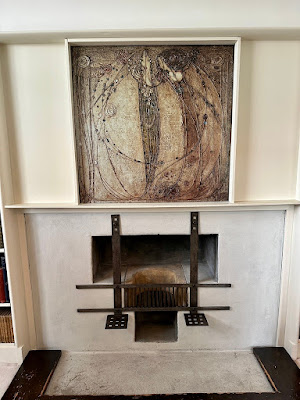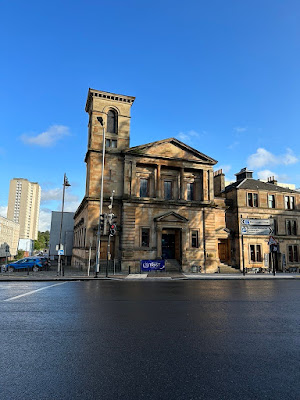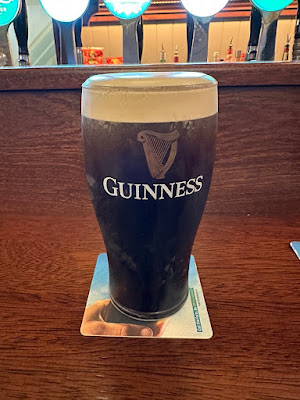In September, I was in England and I made a little trip north to Scotland to pay a visit to Glasgow and Edinburgh. I had previously visited or at least driven through both cities but I had never stopped for too long and I had never really seen the sights.
It is about a 4 hour drive north to Glasgow from Derbyshire and I arrived in Glasgow mid afternoon. One of the main things I wanted to see were the Charles Rennie Mackintosh places. The House, the Willow Tea Rooms, sadly the School of Art was being restored after the recent fire.
 |
| Mackintosh House at the Hunterian |
The first stop was the Mackintosh House at the Hunterian Museum. The house is not the actual house, that got in the way of some other development, so it was demolished in the 60's. The house was recreated on a nearby site and the rooms furnished just as they were in the original house. The recreated house is a part of the Hunterian Art Gallery which is nearby Glasgow University.
 |
| Interior of the Mackintosh House |
Each room is decorated as it was in the original house and of course every little detail from the fireplace to the light fixtures to the tables and chairs and bookcases were all designed to fit together.
 |
| A most beautiful fireplace |
I particularly liked the fireplaces. They all seemed quite wonderful.
 |
| Glasgow University |
The nearby University is a nice collection of old buildings. What was particularly interesting were the Memorial Gates. Installed in 1952 to commemorate 500 years of the University they have the names of many of the prestigious figures that were associated with the University as students or teachers - Adam Smith, Lord Kelvin, Joseph Lister, James Watt, etc.
 |
| Glasgow University Memorial Gates |
I had a nice hotel for the night (the 15 Glasgow) in one of the old impressive terraced houses, a couple of doors down from where Joseph Lister lived. A nice meal in the evening at a restaurant (the Five March) that was trying hard to be cool. It offered a lot of little dishes, all really good but none of which filled me up.
 |
| The National Piping Center, Glasgow |
The next day I walked down the infamous Sauchiehall Street to the National Piping Center. Not being a fan of the Scottish bagpipes, I wasn't expecting much. However it proved to be quite interesting and, surprisingly, there was none of that annoying bagpipe music playing.
 |
| The Willow Tea Rooms |
Back on Saucihall Street, I went into the Willow Tea Rooms. This is another Charles Rennie Mackintosh gem and it is still operating as a tea room and restaurant today. I had tea and scones for a mid morning snack.
 |
| Interior of the Willow Tea Rooms |
The decoration was simply spectacular. What an eye he and his wife had for architecture, interiors and furnishings.
 |
| The Tenement Museum |
The next stop in Glasgow was the Tenement Museum. This is an old tenement flat that has been preserved exactly as it was in the early part of the 20th century. It was another of those places where an elderly person lived and didn't update anything. It was a time capsule from an earlier time that was fortunately bought by someone who knew how rare and important such things are.
 |
| Living Room in Tenement Museum |
The tenement was likely a fine middle class home in its day. Many modern conveniences for its time. Compared to days modern convenience, life was still quite hard in that time.
 |
| Kelvingrove Art Gallery and Museum |
As I was leaving Glasgow I drove past the Kelvingrove Art Gallery and Museum. This looked such an impressive building that I had to stop and take a look. It is a real gem. A very large museum and gallery and it is free entry to anyone (the way such things should be).
 |
| Many wonderful things in the Museum |
I wandered around the museum and art gallery and saw many wonderful things - a spitfire, stuffed animals, an exhibit of the "Glasgow Boys" paintings and even more Mackintosh art. I hadn't heard of the Glasgow Boys but they were quite the community of local artists in their day (the start of the 20th century). I particularly liked James Guthrie and Ernest Hornel's work.
 |
| The Main Hall and the Organ, Kelvingrove |
I finished the tour by listening to an Organ recital. The Museum has an impressive main hall with a wonderful organ at one end and every now and then they give lunchtime organ recitals.
I left Glasgow and drove over to Edinburgh which is only 1 hour away. I had a hotel booked in the New Town area, The Native on Queen Street. Once I figured out how to get the car in the underground parking for the hotel, not an easy job, I left it there for the rest of my stay.
 |
| Salsify, beetroot, swede, sea rocket, nettle mascarpone, seed granola |
I had a reservation for dinner that evening at The Wedgewood restaurant, an early reservation, It was a restaurant where they specialized in locally sourced food, particularly locally foraged food. I had the roast salsify, East Lothian beetroot, fondant swede, sea rocket, nettle mascarpone, and seed granola. Again it wasn't my best meal and again I left feeling hungry.
 |
| Adam Smith Statue |
The walk back from the restaurant took me up the Royal Mile and down to Princes Street. There were many interesting things to see along the way - the Adam Smith statue, the Scott Monument, the Livingstone Statue. It is a remarkable city but there were far more tourists around than I expected to see.
 |
| The Castle from below |
The next morning, I walked over to the Castle area and tried to get in. I was informed it was only accessible with pre-purchased tickets and that normally I would be able to buy tickets on the internet, however, the castle's website was down that morning.
Plan B was to catch the hop on hop off bus tour which I did and I did the entire loop around the city. Fortunately the Hop On/Off bus driver's access to Castle tickets was not down so I got one from him and got off when the bus reached the castle.
 |
| Entry to the Castle |
The castle was very busy. So many tourists. They were dismantling the stands for the Edinburgh Tattoo at the entrance to the castle. A major piece of construction to create a custom set of stands for viewing the tattoo.
 |
| Inside the Castle |
It was all quite nice. There is a lot of history there. Unfortunately as I write this a few weeks later I cannot remember many of the details. I do remember the memorial to the war dead, I do remember a nice little chapel with beautiful stained glass, and a major hall lined with swords and shields and pikes, etc.
As I was getting ready to leave the complex there was a large crowd gathering. Upon asking I found out that everyone was all waiting for the 1 o'clock gun. With 2 minutes to go I waited also. It was a terrific bang and a slight puff of smoke and it was all over. Every day at 1 o'clock.
After the castle I walked down to the Royal Mile again and picked up the Hop on Hop off bus. This took me all the way to the Palace of Holyrood House. Incidentally the rood of the name Holyrood means cross, hence Holyrood is Holy Cross.
 |
| The Palace of Holyrood House |
I had a quick bite of lunch in the cafeteria at Holyrood and then went inside to tour the palace. Holyrood is another of those historic homes that seem to be all over the UK. I enjoy walking through one fine room after another, one more dining hall, another library, bedrooms with beautiful tapestries and four-poster beds. However a few weeks later I am not sure I can distinguish one or another of those rooms from the rooms in Chatsworth House or Haddon Hall. Short term memory and lack of photographs take their toll.
 |
| Holyrood Abbey |
What I do remember however was the abbey adjacent to the palace. This 12th century abbey has suffered some damage during its life, most notably by invading English armies in the 16th century and by mobs during the Scottish Reformation. The roof fell in during the 18th century leaving it in its present state.
 |
| The Gardens at Holyrood |
I then walked through the gardens at the back of the palace where there is a fine view of Arthur's Seat. Leaving the palace I got on the bus again to take me back towards the town.
 |
| The new Scottish Parliament Building |
On the way I passed the new Scottish Parliament buildings. An interesting complex of buildings that would probably be worth a visit someday but by that time I was done.
 |
| St Cuthbert's Church |
 |
| The Ross Fountain |
 |
| Bum, the San Diego Dog |
 |
| The Scott Monument |
After a brief rest at the hotel I went on another walkabout. The magnificent Caledonian Hotel, once the hotel for the Caledonian Railway Station; St Cuthbert's Church, Bum the dog from San Diego, the Ross Fountain, the Scott Monument, the Livingstone Statue.
 |
| The Bar in the Dome |
In the evening a fine meal at a French Bistro and then a drink in the bar at the Dome. I splurged on a 20 year old whisky. Alas not that enjoyable. Perhaps my whisky days are over?
 |
| The Tiffany Window in St Cuthbert's Church |
The next morning I checked out of the hotel and did another small walkabout visiting St Cuthbert's church once more where there is a window by Louis Comfort Tiffany as well as many other fine stained glass windows.
 |
| The Forth Railway Bridge |
Then I left Edinburgh heading north to look at the Forth Rail Bridge. It was always one of my favorite bridges. I used to travel north to Aberdeen on the train when I was working up that way and cross that bridge. I also have fond memories from the film "The 39 Steps".
 |
| Chirdle Hall Hotel |
Heading south I made for Berwick on Tweed. When I got near I searched for a hotel and found a wonderful old house out in the country, The Chirnside Hall Hotel. It was a beautiful old hall that perhaps had half a dozen rooms and also provided meals. It was a nice way to end the trip with a cocktail by the fireside in the living room followed by a really fine meal.
 |
| Eyemouth |
The next morning after the full English breakfast set off south again stopping first in the little fishing village of Eyemouth.
 |
| Memorial sculpture for the 1881 Disaster |
Eyemouth was the site of a tragedy back in 1881 when a storm caused the loss of 20 boats and 129 men from the Eyemouth fishing fleet. There is a sculpture of the wives and children of the fishermen crying out from the shoreline to their men out at sea being pounded by the gale but unable to make land.
 |
| Berwick on Tweed Viaduct |
Next stop was Berwick on Tweed. Another town that I had been enamored with after my train journeys north to Aberdeen. The railway viaduct over the Tweed as you enter the town is most impressive. I walked around the town on what was a Saturday morning. Shops were opening and they were getting ready for the market down the main street.
 |
| Anne Redpath - self portrait |
Berwick is a walled city and after visiting the town we walked along the wall. There was an art gallery, the Granary Gallery, I believe. It had a nice exhibit of paintings by Anne Redpath, a Scottish painter from the first half of the 20th century.
 |
| Lindisfarne Castle |
Driving further south I stopped by Lindisfarne, or Holy Island. This tidal island has a drivable causeway connecting it to the mainland. If the tide is out, as it was when we arrived, you can drive out enjoy the island then return before the tide comes in again and cuts off the island.
 |
| Walking across the mud flats |
The island has become quite popular with tourists and I was amazed at the large number of visitors. Some were making a pilgrimage and were walking across the mud flats to the island. There is an Abbey there and a Castle too. The little village has a couple of pubs and tourist shops.
 |
| The Abbey at Lindisfarne |
I visited the abbey and the adjacent small church and then wandered around the village a bit before stopping in a cafe for coffee and cake. It was then home to Derbyshire before the tide came in.















